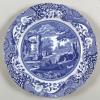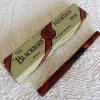Search the Community
Showing results for tags 'date code'.
-
I recently got a used blue Parker Reflex with M nib on ebay for $9 (can't resist a deal on a blue pen!). The date code is II N which according to Parkerpen.net means 1989 (and also 1999, which seems a bit odd). But this pen also has the parallelogram emblem on the clip, which that Parkerpen.net also says was only present for one year, in 2002. I sent a contact form to site owner Tony but no response so far. Anyone shed more light on this apparent discrepancy?
-
This Sailor pocket fountain pen was manufactured in February 1965 (date code H. making it one of the first Sailor pocket pens to be produced. Although, once very common in Japan, they rarely come up for sale now. This is most likely due to the age and owners like to hang on to them. They are unusual which attracted me and they’re surprisingly good for writing. Pocket pens are still popular and make a revival every 15 years. Pocket pens are a rather unusual design (long cap, short barrel) and started by Platinum in the ‘60’s and due to the high demand both Pilot and Sailor soon entered the market with similar designs. As the name says, these pens are made specifically for shirt pockets. 1. Appearance & Design (8/10) This is one of Sailor’s earliest designs: jade coloured section and finial; gold clip; 14k gold nib; and decorative gold trim ring. The price, Y2,000 in 1965, wasn’t cheap which would account for the decorative trim ring which was reserved for more luxurious models. I was not particularly attracted to pocket pens at first but if you haven’t experienced them before, then you’re in for a surprise; very short when capped, yet full size posted; light; and excellent as an every-day-carry. It is sturdily built, uses a full-size Sailor cartridge with a strong clip that holds firmly. The cap has an inner liner to prevent drying and a steel clutch ring providing that snug fit capped or posted. Typical of Sailor, the quality and construction is very good. They came in many colours and I particularly like this Jade version. Personally, I find it difficult to use un-posted but luckily when posted it’s the length of the majority of fountain pens. I enjoy the convenience of a strong clip and that it easily fits in my shirt pocket or suite jacket. Overall, it's a simple design that works for me. 2. Construction & Quality (9/10) Having been protected in the box, the pen has aged well and almost as good as new. I’ve known Japanese quality control is very good, but this is commendable. I can understand why they were in high demand at the time. The pen is light, and excellent balance when posted. It's surprisingly sturdy with the brushed chrome look that will help it age gracefully. As it’s made to post, the cap fits snugly on both the section and the barrel, which is much better than some Pilots where the cap clutch grabs too soon. It has lasted 50 years and looks as good as new. Having used good quality materials, it should easily last another 50 years. 3. Weight & Dimensions (8/10) – Capped: 114mm; Uncapped: 100mm; Posted: 142mm; Diameter: 10mm; Weight: 10g. The pen is lighter than those I normally use. The cap is half the weight of the pen; it posts securely, well balanced and comfortable in the hand. It’s a pleasure to use. 4. Nib & Performance (7/10) – It has a 14k gold nib with no size indication on the nib but the price label has 細 which I’m told means fine. The nib is definitely springy almost semi-flex and writes quite smoothly, definitely not toothy or scratchy. Since it is such good condition I was reluctant to fill the pen and only dip tested for the writing sample with Sailor Souboku. It’s been subsequently cleaned and dried for storage. It had no difficulties laying a consistent fine line, an advantage of a nib matched to a good feed. The nib and section can be easily removed but not necessary since it’s NOS. The feed holds a surprising amount of ink. Given the age, if you prefer a wider nib then you may have difficulty but they are around. 5. Filling System & Maintenance (7/10) – The barrel takes a full sized proprietary cartridge. The earlier models came with a cartridge converter but I have never seen any. Luckily there are two cartridges provided which can be refilled. The nib and feed can be extracted by unscrewing the nipple, and pushing them up the section. 6. Cost & Value (8/10) –It’s a NOS vintage pen in very good condition with box and papers so would generally attract the attention of collectors, which artificially inflates the price. I have seen a few pocket pens even by Sailor but this is the first of the 1960’s luxurious pens that I’ve seen. A pen by itself, in average condition, sells for US$35-US$50. This pen including the box, instructions, and original cartridges may sell for US$50-US$70. Would I buy one for US$60? If I was looking for a pocket pen then why not pick the best. I was quite surprised how quickly I got used to the pen even if it does have a fine nib then of course it would be attractive and definitely a talking point, so for that price I would buy one. 7. Conclusion (Final score, 47/60) – Overall, there are a number of features that make this pen special: compact design; attractive appearance; springy semi-flex nib; and a good solid gold clip. The only negative is the lack of cartridge convertors so it will always be a cartridge-only pen. Initially, I wasn’t attracted to pocket pens but now I’ve tried one they will definitely be on my wish list. I like it, it’s different and looks quite attractive when capped and I love the jade colour when it’s posted. It makes a nice daily writer, built well and will survive the occasional knock without showing it. It’s such a good writer it would be a shame if this one goes to a collector but it’s understandable. With care this one will easily last another fifty years. It’s definitely a go-to pen for those that love fine nibs. Other pictures: https://imgur.com/a/qUgCtoh
-
I have several different Parkers now--51s, Rialtos, Vectors. I read that there's a date code on each pen. I found the key on parkerpens.net, but I can't see any code on any of the pens other than the F or M for the nib. Is there a trick to finding it?
-
Hello fellow FPNers! I purchased this 51 Vac today at a flea market for the grand total of $5. I was super excited to find a 51 (of any variety) for such a sumgai price, but upon closer inspection, I came away with a few concerns. I searched the barrel, even with a loop, and there is no date code or PARKER "51" anywhere on the barrel. However, there is a deeply impressed "5" on the underside of the hood. Does anyone have any idea what the 5 means and why there would not be a date code on the barrel. The pen in question is a dove gray 51 Vacumatic. It is a later model that is single-jewelled with the transitional cap (1947-48) that has the long arrow clip and wide cap lip that has "PARKER" on the front. Here is a photo of the hood: http://i966.photobucket.com/albums/ae149/thefancyman/DSCF5363_zps6lnzd6x7.jpg
-
I have recently purchased a Parker 95 Flighter which has a date code of TE which is 3 years before this model was officially launched. I'm sure it's a 95 and not an Arrow as it has the single feathered clip. It came in the original box which is labelled 95 S/S G/T which is the correct description. Any thoughts from anyone who may know why this is the case.
-
Hi, I'm trying to date this parker duofold, Can't find any material on the nib code which helps me to do this. Any help would be much appreciated. Also, i'd like to know how to read the number&dot code on the nibs of some old parkers. Nib has standard markings (parker, 14CT made in england) and at the base has: 15 4 . . . Many thanks! http://i.imgur.com/B3VbvTGl.jpg http://i.imgur.com/P1m2Crnl.jpg http://i.imgur.com/nj0kadol.jpg








